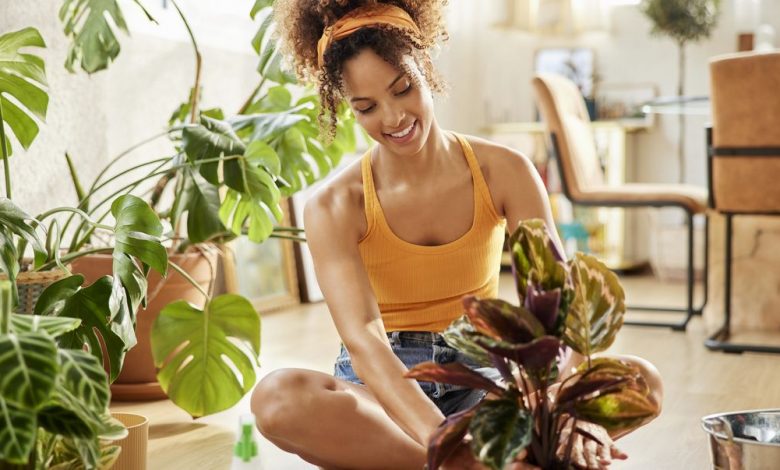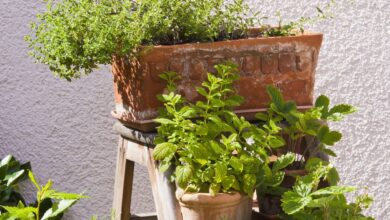If some of the best indoor houseplants have taken over your interiors, seemingly sprawling across bookshelves, side tables and kitchen countertops, you’re not alone. Sales of leafy green flora have soared over the past couple of years as many spend more time indoors; they’ve been a hit on platforms like TikTok and Instagram, where there are more than 9 million posts tagged #HousePlants. While the greenery brightens up your space and certainly looks cute, experts believe your indoor plants may be good for your health, too.
Naturopathic doctors have long incorporated plant medicine into their practices, and generally spending time around plants offers a “whole-person positive impact,” says Amy Rothenberg, N.D., a naturopathic doctor and president of the Massachusetts Society of Naturopathic Doctors.
“When we talk about treating the whole person, we mean looking after the body, the emotions and the spirit; plants can touch each of those essential areas,” Rothenberg explains. Plants improve air quality, bring beauty into your home and boost emotional and spiritual wellbeing by giving you a chance to care for something. Plants in your bedroom could improve your sleep quality, while greenery in your kitchen helps brighten up your space if there’s no window.
While any plant is good for the soul and can benefit your mental health and emotional wellbeing, here are some of experts’ top choices.
What plants are best for your health?
The healthiest houseplant is the one that matches your personal style as well as daily schedule and routine, says Alex Cromer, LPC, a licensed professional mental health counselor with Thriveworks in Richmond, Virginia. And, don’t worry too much if you don’t have a green thumb! Many of the best plants for your health are easy to care for, so you can enjoy their presence and reap the health rewards.
1
Spider Plant
Spider plants, or Chlorophytum comosum, are extremely easy to grow, don’t require constant attention and thrive with little investment on your behalf. The plants have narrow leaves and get their name from the “small plantlets produced on long trailing stems that vaguely resemble spiders,” according to the University of Wisconsin-Madison Division of Extension.
Spider plants are known to help purify the surrounding air. NASA research examined the leaves, soil, roots and microorganisms of several houseplants and found that plants can act as a natural air filter to reduce pollutants. The study indicates that spider plants removed 95% of toxic formaldehyde from the air in a sealed Plexiglas container over a 24-hour period.
SHOP SPIDER PLANT
3
Rubber Plants
Rubber plants — also known as rubber trees or Ficus elastica — make for great indoor houseplants. They’re generally easy to take care of and only need to be watered every week or so, according to materials shared by The Sill. Research shows that rubber plants feature air-purifying properties. Just be sure to keep them firmly away from any pets and from young children, as they’re known to be highly toxic when ingested.
SHOP RUBBER PLANT
4
Elephant Ear Plants
If you want to spend a little more time with your houseplants, Cromer recommends elephant ear plants. These are organized into a group of tropical, perennial plants instantly recognizable by their big, heart-shaped leaves. They need bright light and regular watering to keep the soil moist, and they can get big and may need extra space. Some species have been grown for their edible starchy tubers, which are a food staple in certain tropical regions. Medicinally, the leaves have been noted for their use in treating insect stings.
SHOP ELEPHANT EAR PLANT
6
Ferns
A 2022 study published in Applied Sciences showed that Boston ferns performed best when it comes to air cleaning by naturally VOCs from the air. The plants grow easily and look the best indoors in hanging baskets or on plant stands, which allow their fronds to drape. They need medium bright light and consistently moist soil, so they might require a bit more of your time.
SHOP FERNS
7
Pothos
When you picture a houseplant, the pothos, or Epipremnum pinnatum, is likely what comes to mind. Also known as devil’s ivy or golden pothos, the plants feature vibrant heart-shaped leaves that may be green or marbled green and yellow. They’re easy to grow, needing only indirect sunlight and infrequent watering. Research shows that the plants can lower indoor ozone levels, which can make it easier to breathe and reduce your risk for respiratory ailments, as well as remove VOCs from the air.
SHOP POTHOS
10
Herbs
Small potted herbs not only look cute in your kitchen, but they may also inspire you to cook more often and eat healthier. Growing your own basil, parsley, or mint is also cheaper than purchasing herbs from the grocery store. Several herbs, like chamomile and lavender, have been shown to reduce anxiety, per Mayo Clinic officials. Herbs also contain vitamins, minerals, and antioxidants, which are a boon for your dietary routine.
SHOP HERBS
How do house plants contribute to good health?
The beauty of plants and the act of caring for them can be truly healing. “Looking at something aesthetically pleasing can boost neurotransmitters like dopamine and serotonin,” Cates explains. Keeping plants primes your brain to look forward to interacting with the plant and receiving a hit of “feel good neurochemicals,” Cromer adds.
Plants offer immediate benefits by improving mood and stress management, Cates says. They also provide long-term benefits, such as improving air quality which may reduce instances of headaches — or by adding moisture to the air, which helps with dry skin, Rothenberg says. Handling soil, which contains microbes, can promote microbiome diversity in your home, which could benefit gut and skin health.
But, having houseplants alone isn’t a recommended treatment for any medical condition, Rothenberg adds. “Encouraging my patients to consider having houseplants is one part of a broader, individualized health care plan.”
What are the best indoor plants for air purification?
Research shows that plants can help with air purification, especially in areas where air quality may be in question. Breathing cleaner air also helps you think clearer, calms stress, and reduces the risk for asthma, Cates tells Good Housekeeping.
Houseplants absorb carbon dioxide, filter pollutants and release oxygen. “This is an important idea considering how much time people spend indoors,” Rothenberg adds. “By adding more oxygen, theoretically, you might have better focus, fewer headaches, and an improved mood.”
Snake plants, spider plants, rubber plants, peace lilies, ferns, and English ivy are some of the best indoor plants for boosting oxygen levels and purifying the air.
What are the mental health benefits of caring for a houseplant?
Being around greenery offers many mental health benefits. Horticultural therapy has long been used to treat mental health and other conditions. It helps improve memory, cognition and socialization. Humans also have an innate instinct to connect with nature, known as biophilia.
Caring for plants can reduce stress and anxiety, improve mood and concentration, and boosts confidence. “Plants provide a tangible, positive result for the caretaker which can help them feel more in control of their lives, something that can reduce anxiety and promote overall wellness,” Cromer says. “It gives the caretaker a sense of pride and accomplishment—being observant of how the plant is growing, looking, and to troubleshoot ways to solve problems.”
Watching them grow can be soothing, promote peaceful feelings, and provide a meditative experience, Rothenberg adds.
“Plants benefit health holistically because they are a non-stimulating partner that is accepting and tolerant, and are good listeners,” Cromer says. “Plants thrive with simple care and attention and are very visibly thankful for your efforts.”
If you are dealing with a mental health condition, you may need to speak with a professional. You can find help and learn more about anxiety by visiting the Anxiety and Depression Association of America.
Erica Sweeney
Erica Sweeney is a writer who mostly covers health, wellness and careers.
This content is created and maintained by a third party, and imported onto this page to help users provide their email addresses. You may be able to find more information about this and similar content at piano.io







